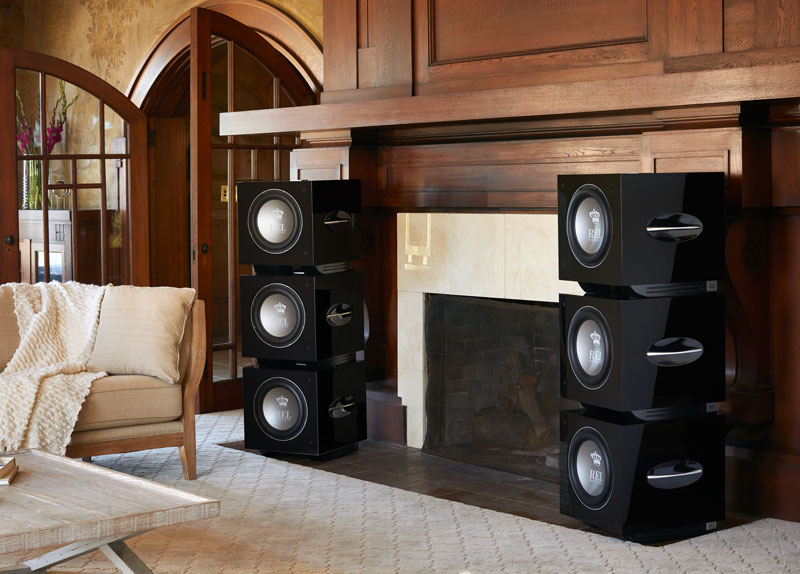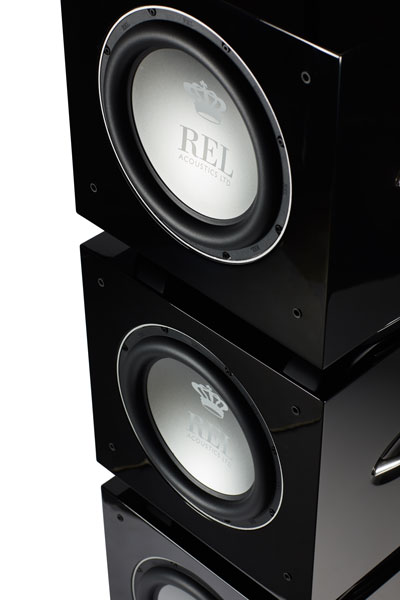Blog
Taking Bass To New Heights With Serie S Line Arrays

One of the coolest, most desirable attributes of the new Serie S/510 and S/812 are their ability to transform into REL Line Arrays. Now mere mortals can take on super human powers. These grand cru stacks of powerhouse RELs have previously been the exclusive domain of our Reference Line, but during the course of developing the drivers for the new S we noticed one attribute that makes stacking possible and we set about exploiting this unique capacity to its fullest.
Let’s explore the purpose to our Line Array approach because, let’s face it, if you haven’t heard one you might well think this is just about pure power and ludicrous mode output. While you wouldn’t be wrong about their potential for massive output (an 812 array produces 6,000 watts of continuous, not peak, power with some 700 square inches of main driver with another 700 square inches of passive radiators exhaling into the room) the true reason for owning a REL Line Array has more to do with all the amazingly tactile qualities the highest end music and film sound systems aspire to.
Open effortless sound staging, speed, delicacy, slam, warmth, body, holographic imaging, and movie sound that rises to and fills the entire height of the screen – most home theatre never lofts onto the screen leaving that movie magic more about bombast than full height-of-screen spellbinding.

The attribute in our latest range of drivers that jumped out was near-reference levels of power combined with class leading self-quieting. The latter refers to a 10” or 12” driver’s ability to output tremendous levels of sound, then immediately quiet without continuing to ring. It takes both of these to make a Line Array truly state of the art. We’d never experienced it before with anything other than our expensive carbon fibre drivers, yet here we had it right in front of us and we became really excited when we developed the final package and realized that this could be accomplished at around half the cost and size of our reference models.
Are they as good as the Reference? No, there are reasons our big dogs have those special cabinets, unique features like the parametric EQ of the No.25 and specialized amplifiers. But we believe that taken as a whole, the new Serie S set new standards for medium-sized and accessibly priced subwoofers.
Line arrays aren’t just about stacking subs to make more output. Each subwoofer’s output pattern—how sound emanates from each sub must be compatible with the vertical stacking feature or more harm than good can take place. Each sub in a proper line array must be individually adjustable for every parameter–output volume, crossover setting and phase–in order to properly tune the line array.
As I travel around, people sometimes ask if we could save money if we just built three drivers into a cabinet. The answer is a resounding no. Putting three drivers into one cabinet with one amplifier is very different than using three different subwoofers that can each be tuned (crossover and volume) independently. Thus, a single unit with three drivers would no longer be capable of delivering all the careful tuning needed to have it transform a very fine loudspeaker into a sound field happy owners feel as though they could take a flying leap into, it’s so solid and spacious.
Let’s turn our attention to addressing some practical realities. First up, the cost of an S Line Array is still not trivial (although half the price of the G-1 MkII). But keep in mind that one of the key points that makes the Line Array approach so attractive is that buying them in pairs over a period of months or years means that the outlay can be manageable for a concept that delivers true state of the art performance.
Try doing that if you aspire to, say, a pair of great monoblock amps that typically set one back around $30,000 (£20,000) per pair. With progressive builds of a Line Array, each stage of upgrading the improvement is immediately audible.

Many people have an image in their mind that Line Arrays are towering physical structures that are intimidating in scale and menacing in appearance. In fact, the Serie S Line Arrays are remarkable for their attractive and manageable scale. We have an S/510 Line Array that uses a pair of full range electrostatic Martin Logan CLS and the reaction of all who have heard them is how compact the Line Array is. Comments typically fall into the “WOW, I always thought this would be really huge but these look great and aren’t too large at all.”
The S/510 stack is amazingly flexible and is able to underpin everything from near reference speakers such as the wonderful Wilson Sasha DAW, the Focal Sopra 3’s or the Bowers and Wilkins 800 twins (802 D3 and 800 Signatures) all the way down to affordable quality floorstanders. We use a pair of older Sonus Faber Toy Towers as an everyday speaker and they blend effortlessly with them, so both sonically and visually the Line Array underpins a broad palette of high end speakers.
Until one experiences a Serie S Line Array properly setup and dialed in (incredibly easy and intuitive, takes maybe one hour from start to finish) it is hard to understand the profound leap from mundane to edge of the art these afford. The sound quality, visual presentation and sophisticated and beautiful forms these deliver elevates merely very good systems to a whole different and better-in-every-way delivery of music and film sound. Seek one out at a dealer near you, they’re simply incredible performance value and style.
Building up to a Line Array
Most REL line arrays are built up over time, with each successive pair being added in stages. If you think a line array is utterly out of reach, watch our Sound Insights video to learn how building up to a line array over time can be more practical while helping you better appreciate the verticality and performance it adds to your system.











